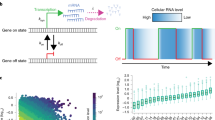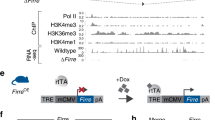Abstract
Among a number of genes that escape X–chromosome inactivation in humans, three have been evaluated in mice and unexpectedly all three are subject to X–inactivation. We report here the cloning and expression studies of a novel mouse gene, Xe169, and show that it escapes X–inactivation like its human homologue. Xe169 was assigned to band F2/F3 on the mouse X chromosome by fluorescent in situ hybridization and Southern analysis indicates that the gene is located outside the pseudoautosomal region. Homologous, but divergent, sequences exist on the Y chromosome. In vitro and in vivo studies show that Xe169 is expressed from both the active and the inactive X chromosomes. Xe169 is the first cloned non–pseudoautosomal gene that escapes X–inactivaton in mice.
This is a preview of subscription content, access via your institution
Access options
Subscribe to this journal
Receive 12 print issues and online access
$209.00 per year
only $17.42 per issue
Buy this article
- Purchase on Springer Link
- Instant access to full article PDF
Prices may be subject to local taxes which are calculated during checkout
Similar content being viewed by others
References
Gartler, S.M. & Riggs, A.D., Mammalian X-chromosome inactivation. A. Rev. Genet. 17, 155–190 (1983).
Grant, S.G. & Chapman, V.M. Mechanisms of X-chromosome regulation. A. Rev. Genet. 22, 199–233 (1988).
Ballabio, A. & Willard, H.F. Mammalian X-chromosome inactivation and the XIST gene. Curr. Op. Genet. Dev. 2, 439–447 (1992).
Lyon, M.F. Some milestones in the history of X-chromosome inactivation. A. Rev. Genet. 26, 17–28 (1992).
Ashworth, A., Rastan, S., Lovell-Badge, R. & Kay, G. X-chromosome inactivation may explain the difference in viability of XO humans and mice. Nature 351, 406–408 (1991).
Abler, D.A., Bressler, S.L., Chapman, V.M., Page, D.C. & Disteche, C.M. Inactivation of the Zfx gene on the mouse X chromosome. Proc. natn. Acad. Sci. U.S.A. 88, 4592–4595 (1991).
Kay, G.F. et al. A candidate spermatogenesis gene on the mouse Y chromosome is homologous to ubiquitin-activating enzyme E1. Nature 354, 486–489 (1991).
Zinn, A.R. et al. Inactivation of the Rps4 gene on the mouse X chromosome. Genomics 11,1097–1101 (1991).
Wu, J. et al. Isolation and characterization of XE169, a novel human gene that escapes X-inactivation. Hum. molec. Genet. 3, 153–160 (1994).
Feinberg, A.P. & Vogelstein, B. A technique for radiolabeling DNA restriction endonuclease fragments to high specific activity. Anal. Biochem. 132, 6–13 (1983).
Lau, E.C., Mohandas, T.K., Shapiro, L.J., Slavkin, H.C. & Snead, M.L. Human and mouse amelogenln gene loci are on the sex chromosome. Genomics 4, 162–168 (1989).
Salido, E.C., Passage, M.B., Yen, P.H., Shapiro, L.J. & Mohandas, T.K. An evaluation of the inactive mouse X chromosome in somatic cell hybrids. Somatic Cell. molec. Genet. 19, 65–71 (1993).
Searle, A.G. (abstr) Heredity 17, 297 (1962).
Lyon, M.F., Searle, A.G., Ford, C.E. & Ohno, S. A mouse translocation suppressing sex-linked variegation. Cytogenet. 3, 306–323 (1964).
Tagaki, N. Primary and secondary nonrandom X chromosome inactivation in early female mouse embryos carrying Searle's translocation T(X;16)16H. Chromosome 81, 439–459 (1980).
Keitges, E., Rivest, M., Siniscalco, M. & Gartler, S.M. X-linkage of steroid sulphatase in the mouse is evidence for a functional Y-linked allele. Nature 315,226–227 (1985).
Shapiro, L.J., Mohandas, T., Weiss, R. & Romeo, G. Non-Inactivation of an X-chromosome locus in man. Science 204,1224–1226 (1979).
Brown, S.D.M. et al. Mouse X chromosome. Mamm. Genome 4, S269–S281 (1993).
Sambrook, J., Fritsch, E.F. & Maniatis, T. Molecular Cloning: A Laboratory Manual 2nd edn (Cold Spring Harbor Laboratory Press, Cold Spring, 1989).
Matsuda, Y. et al. Location of the mouse complement factor H gene (cfh) by FISH analysis and replication R-banding. Cytogenet. Cell Genet. 61, 282–285 (1992).
Feng, G.S. et al. Receptor-binding, tyrosine phosphorylation and chromosome localization of the mouse SH2-containing phosphotyroslne phosphatase Syp. Oncogene (in the press).
Heng, H.H.Q., Squire, J. & Tsul, L.-C. High resolution mapping of mammalian genes by in situ hybridization to free chromatin. Proc. natn. Acad. Sci. U.S.A. 89, 9509–9513 (1993).
Heng, H.H.Q. & Tsui, L.-C. Modes of DAPI banding and simultaneous in situ hybridization. Chromosoma 102, 325–332 (1993).
Yen, P.H., Ellison, J., Salido, E.C., Mohandas, T.K. & Shapiro, L.J. Isolation of a new gene from the distal short arm of the human X chromosome that escapes X-inactivation. Hum. molec. Genet. 1, 47–52 (1992).
Borsani, G. et al. Characterization of a murine gene expressed from the Inactive X chromosome. Nature 351, 325–328 (1991).
Author information
Authors and Affiliations
Rights and permissions
About this article
Cite this article
Wu, J., Salido, E., Yen, P. et al. The murine Xe169 gene escapes X–inactivation like its human homologue. Nat Genet 7, 491–496 (1994). https://doi.org/10.1038/ng0894-491
Received:
Accepted:
Issue Date:
DOI: https://doi.org/10.1038/ng0894-491
This article is cited by
-
The Sex Chromosome Trisomy mouse model of XXY and XYY: metabolism and motor performance
Biology of Sex Differences (2013)
-
Inefficient purifying selection: the mammalian Y chromosome in the rodent genus Mus
Mammalian Genome (2006)
-
Escape from X inactivation of Smcx is preceded by silencing during mouse development
Nature Genetics (1998)
-
A proposed path by which genes common to mammalian X and Y chromosomes evolve to become X inactivated
Nature (1998)
-
Analysis of mutation rates in the SMCY/SMCX genes shows that mammalian evolution is male driven
Mammalian Genome (1997)



